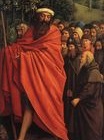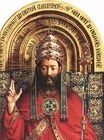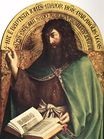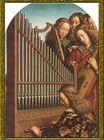Jan van Eyck - The Ghent Altar, detail 1432
 |
 |
 |
 |
 |
 |
 |

The Ghent Altar, detail 1432
oil on wood
St. Bavo Cathedral, Ghent, Belgium
<< Previous G a l l e r y Next >>
From Wikipedia, the free encyclopedia:
The Ghent Altarpiece (or the Adoration of the Mystic Lamb, Dutch: Het Lam Gods) is a very large and complex 15th-century polyptych altarpiece in St Bavo's Cathedral, Ghent, Belgium. It was begun c. the mid-1420s and completed before 1432, and is attributed to the Early Netherlandish painters and brothers Hubert and Jan van Eyck. The altarpiece is considered a masterpiece of European art and one of the world's treasures.
The three central upper panels show a Deësis of monumental and enthroned figures, each with a halo. They are the Virgin Mary to the left, John the Baptist to the right, and a central figure who may be either God or Christ – a distinction much debated amongst art historians. Theories include that the panel shows Christ in Majesty dressed as in a priest's vestments, God the Father, or the Holy Trinity amalgamated into a single person. The figure looks towards the viewer with his hand raised in blessing, in a panel filled with inscriptions and symbols. There are Greek inscriptions decorated with pearls on the hem of his robe or mantle, which, taken from Revelation, read REX REGUM ET DOMINUS DOMINANTIUM ("King of Kings, and Lord of Lords").
The golden brocade on the throne features pelicans and vine, probable references to the blood spilled during the Crucifixion of Jesus. Pelicans were at the time believed to spill their own blood to feed their young. The vines allude to sacramental wine, the eucharistic symbol of Christ's blood.
The crown is at his feet, and on either side the step is lined with two levels of text. The left hand upper line reads VITA SINE MORTE IN CAPITE ("Life without death on his head"), that on the right IUVENTUS SINE SENECTUTE IN FRONTE ("Youth without age on his forehead"). These are placed above—on the left and right respectively—the words GAUDIUM SINE MERORE A DEXTRIS ("Joy without sorrow on his right side") and SECURITAS SINE TIMORE A SINISTRIS ("Safety without fear on his left side").
Mary reads from a girdle book draped with a green cloth. The book is an unusual attribute for Mary, and might be based the figure on Robert Campin's Virgin Annunciate. She wears a crown adorned with flowers and stars, and is dressed as a bride. The inscription on the arched throne above reads: "She is more beautiful than the sun and the army of the stars; compared to the light she is superior. She is truly the reflection of eternal light and a spotless mirror of God". Like Mary, John the Baptist holds a holy book – likewise an unusual attribute, and one of 18 books in the set of panels. He wears a green mantle over a cilice of camel-hair. He looks towards the Almighty in the center panel, with his hand also raised in blessing, uttering the words most typically associated with him, ECCE AGNUS DEI ("Behold the Lamb of God").
It is often assumed that given the foreshortening seen in the representation of God the Father, the artist was familiar with the either of the Italian painters Donatello or Masaccio. Susie Nash believes van Eyck was already leading toward this development, and it was something he was "perfectly capable of producing without such models", and believes the technique represents "a shared interest [rather than] a case of influence."